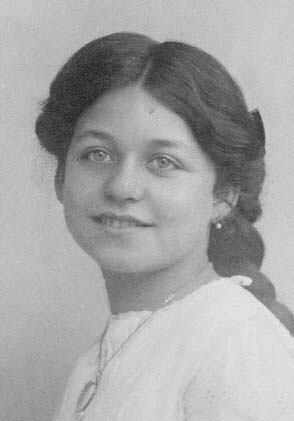Search for Names, Places and Biographies
Already layed Stumbling Stones
Suche
Gertrud Rosenbaum * 1898
Isestraße 61 (Eimsbüttel, Harvestehude)
1941 Lodz
1942 ermordet in Chelmno
further stumbling stones in Isestraße 61:
Josepha Ambor, Else Baer, Hedi Baer, Ingrid Baer, Joseph Baer, Minna Benjamin, Rosalie Benjamin, Emma Dugowski, Henriette Dugowski, Hermann Dugowski, Ida Dugowski, Moritz Dugowski, Wanda Dugowski, Selly Gottlieb, Heinrich Ilse, Ella Meyer, Max Meyer, Otto Meyer, Gregor Niessengart, Sophie Philip, Michael Pielen, Edmund Sonn
Gertrud Rosenbaum, born on 22 Feb. 1898 in Hamburg, deported on 25 Oct. 1941 to Lodz
Isestraße 61
Gertrud Rosenbaum worked as a youth leader in the Jewish People’s Home (Jüdisches Volksheim) at Wohlers Allee 58 in Altona. In the 1920s, more than 2,000 Jews resided in Altona. After the First World War, many Jews moved to Germany from countries located farther to the east for political and economic reasons. Whereas Hamburg denied them entry, many found a new place to stay in Altona, which before 1937 did not belong to Hamburg yet.
As a youth leader, Gertrud Rosenbaum took care of the children of Jewish migrants, often called "Eastern European Jews” ("Ostjuden”). In the Jewish People’s Home, she worked together with a teacher, a housekeeper, and several female trainees. Up to 60 children were able to learn, eat, and play there. The basement featured washing facilities. From the Jüdisches Gemeindeblatt, one can gather that Gertrud Rosenbaum also gave lectures, for instance, in Feb. 1929 on the topic of "parents’ home and after-school daycare center.” The lecture had been organized by the Women’s League of Honorary Employees in the Welfare Association (Frauenbund für ehrenamtliche Mitarbeiter in der Wohlfahrtspflege) headed by Sidonie Werner.
After the beginning of the National Socialist dictatorship in 1933, the funding for the Jewish People’s Home was reduced further, while poverty among the immigrated Jewish families became increasingly greater. Putting in considerable personal effort, Gertrud Rosenbaum tried to find remedies. However, the anti-Jewish laws and the mergers of aid organizations had the consequence that the People’s Home on Wohlers Allee was forced to close.
The children’s after-school daycare center was relocated to Grünestrasse. In Oct. 1936, Gertrud Rosenbaum was dismissed. Afterward, she lived in Berlin for a short time, though subsequently returning to Hamburg. She changed accommodations several times. Her brother, Dr. Eduard Rosenbaum, a economist, supported his sister from London with a monthly allowance. She passed on half of the sum to her father Samuel Rosenbaum, who lived on the first floor of Klosterallee 24, presumably in the boarding house of Grete Marcus. After her deportation to Riga on 6th of December 1941 the boarding house was closed. Samuel Rosenbaum moved to Laufgraben 37, an elderly home of the Jewish community. A few weeks later, on February 5, 1942, Samuel Rosenbaum died. He was buried next to his wife Minna, née Marcus, who died on 26.10.1935, in the Jewish Cemetery Hamburg Ilandkoppel.
In 1938, the Polish-Jewish immigrants were forced to leave Germany in connection with the so-called "expulsion of Polish Jews” ("Polenaktion”). Gertrud Rosenbaum knew many of these expelled people personally from work. In Apr. 1939, Gertrud Rosenbaum moved to Isestrasse, where she lived as a subtenant with the Max Meyer family until she was deported to Lodz. According to the deportation list, she "volunteered.” The list indicates as her occupation "factory worker,” probably a clue to her being compelled to perform forced labor at a Hamburg plant prior to deportation.
In the Lodz Ghetto, she was assigned a living quarter at Hohensteiner Strasse 43. As one of few Hamburg Jews, she found work as a teacher there. However, in the ghetto, it was not possible to maintain the school organized by the camp occupants for long. In keeping with the plans of the Nazi ghetto supervision, the older children were supposed to work and the younger ones to be murdered. At any rate, Gertrud Rosenbaum was not allowed to continue her work, thus losing the last chance of extending her life in the ghetto. In May 1942, she was suffocated using poison gas in the Chelmno extermination camp.
Gertrud Rosenbaum's siblings Max (1886-1967), Eduard (1887-1979), Elsa (1889-1982) and Erich (1891-1954) survived the Holocaust abroad.
Her brother Albert, born in 1888, had fled to Holland in 1934. He was deported from the Westerbork internment camp to the Sobibor extermination camp on July 6, 1943, and murdered on July 9, 1943. Albert Rosenbaum is commemorated by a Stolperstein at Heidberg 65 in Hamburg-Winterhude.
Gertrud's brother Max Rosenbaum (later Rozenbaum) deposited memorial sheets for Gertrud and Albert Rosenbaum at the Yad Vashem memorial in 1955.
Translator: Erwin Fink/Additions from Christina Igla by Beate Meyer
Kindly supported by the Hermann Reemtsma Stiftung, Hamburg.
Stand: December 2022
© Maike Grünwaldt/Christina Igla
Quellen: 1; 4;5; 8; StaH, 621-1 Firmen; StaH, 522-1 Jüd. Gemeinden, Sa 1224; Jürgen Moysich, Wohlers Allee 58: Zur Geschichte des ehemaligen jüdischen Volksheims, Hamburg 1996; Jens Michelsen, Jüdisches Leben in der Wohlers Allee, Hamburg 1993; Gordon J. Horwitz, Gettostadt, Cambridge 2008, S. 192f.; www.geni.com, www.ancestry.de; https://agora.sub.uni-hamburg.de/ (Hamburger Adressbuch online) www.yad-Vashem.org(alle abgerufen am 02.12.2022) Grabregister des Jüdischen Friedhofs Hamburg Ilandkoppel. "Spätes Gedenken-Ein Geschichtsverein erinnert sich seiner ausgeschlossenen jüdischen Mitglieder" Hrsg. Joist Grolle und Andreas Schmoock, Edition Temmen, 2009, Seiten 137-157, 239.
Zur Nummerierung häufig genutzter Quellen siehe Link "Recherche und Quellen".


